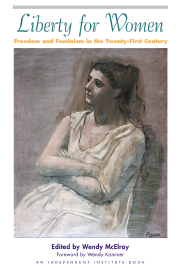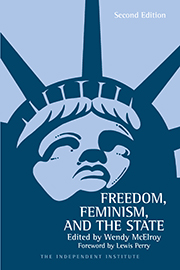On May 15th, the United States Supreme Court’s ruling on U.S. v. Morrison invalidated a key section of the 1994 Violence Against Women Act (VAWA). This provision of federal law allowed a victim of rape or other violence “motivated by gender” to sue the perpetrator for civil damages in federal court for violating her civil rights. By a vote of 5-4, that provision was deemed unconstitutional. Chief Justice William H. Rehnquist wrote the majority opinion in which he stated that a civil remedy for such a crime could be justified neither by the Commerce Clause nor by the 14th Amendment. Both of these sections of the Constitution had been used to support the VAWA during the lengthy Congressional hearings that preceded the Act’s passage. The National Organization for Women’s Legal Defense and Education Fund had reiterated the two constitutional claims while arguing before the Supreme Court in support of the VAWA.
Why were the Commerce Clause and the 14th Amendment invoked to punish rapists on a federal level, and what caused the Supreme Court to invalidate the civil damages provision of the VAWA?
Background of U.S. v. Morrison
The VAWA was part of the 1994 Omnibus Crime Bill. The Act established both a federal right to be “free from crimes of violence motivated by gender” and a federal remedy for violating that right: namely, a new tort claim that included both compensatory and punitive damages. The federal claim was not meant to replace punishment by state criminal statutes, but to supplement them.
In 1995, Christy Brzonkala became the first person to sue federally under the VAWA over a rape that allegedly occurred in her dormitory room while she was a student at Virginia Polytechnic Institute. The men accused—two black football players named James Crawford and Antonio Morrison—had been cleared by both a university judicial committee and a criminal grand jury. Nevertheless, Brzonkala brought a case against them in federal court. In 1999, the U.S. Court of Appeals for the Fourth Circuit (Richmond, Va.) ruled against her, saying that Congress had exceeded its constitutional authority in passing the VAWA. After the defendants challenged the constitutionality of the VAWA, the matter eventually came before the Supreme Court where NOW argued on behalf of the Act. In its decision, the Supreme Court stated that the issue under consideration was “Did Congress exceed its powers when it gave victims of sex crimes the right to file civil lawsuits against their attackers?” Ultimately, the issue under legal debate hinged on the constitutionality of the VAWA.
Two constitutional arguments were used to support the Act. First: violence against women interferes with interstate trade and, thus, violates the Commerce Clause by which Congress may regulate commerce to ensure the free flow of goods and services. Second: the 14th Amendment protects citizens against violation of their due process, which occurred in Brzonkala’s case because state courts were indifferent to violence against women.
The Commerce Clause and the VAWA
The Commerce Clause of the Constitution (Article I, Section 8, Clause 3) delegates to Congress the power to “regulate Commerce with foreign Nations, and among the several States, and with the Indian Tribes.” The Clause gave a broad grant of authority over commerce to Congress without clearly delineating restrictions on that power. The purpose was to overcome the tendency of states to interfere with trade through measures such as tariffs, a practice that had caused great problems under the Articles of Confederation especially for the smaller states. Interstate commerce was deemed to require uniform law if national trade were to be encouraged. According to the Cato Handbook for Congress, “Framers gave Congress the power to regulate—or ‘make regular’—commerce among the states. It was thus meant to be a power primarily to facilitate free trade.”
Subsequent court decisions, dating from the days of F.D.R.’s New Deal, have interpreted the Clause in such a manner as to grant Congress the right to regulate virtually anything that affects interstate commerce. As a result, the Handbook observes, Congress began to use the regulation of commerce among the states “for all manner of social and economic purposes, actually frustrat[ing] the free flow of commerce.” For example, the Church Arson Prevention Act of 1996 gave the federal government power to prosecute those who burned down churches on the grounds that such arson impeded “individuals in moving interstate.” With such broad interpretations, Congress has repeatedly used the Commerce clause to regulate non-economic behavior conduct that crosses state lines, such as child custody.
Advocates of state’s rights have opposed Congress’ expanding power under the Commerce Clause because the increased federal authority often infringes on areas that have traditionally been under the jurisdiction of the states.
A tug-of-war is being currently going on between the U.S. Supreme Court and Congress. For example, in 1995, the Court ruled (5 to 4) in United States v. Lopez that Congress had exceeded its authority in passing the Gun-Free School Zones Act of 1990 which prohibited the possession of a firearm within 1,000 feet of a school. In defending the Act before the Court, the Clinton Justice Department used the Commerce Clause. Guns and crime disrupt education and this, in turn, disrupts the employment opportunities of students, which affects interstate commerce. Again, Chief Justice Rehnquist wrote the majority decision. He stated, “Under the theories that the Government presented,...it is difficult to perceive any limitation on federal power, even in areas such as criminal law enforcement or education where states historically have been sovereign. Thus if we were to accept the Government’s arguments, we are hard-pressed to posit any activity by an individual that Congress is without power to regulate.” In September 1996, Congress again passed the Gun-Free School Zones Act.
Two years earlier, Congress had used the Commerce Clause as justification for passing the VAWA. Advocates stated that violence against women and fear of violence reduced women’s productivity and mobility as employees. Women commonly lose their jobs after being so injured, it was argued. The cost of gender violence to the national economy was estimated at between $5 billion and $10 billion.
In 1999, the Fourth Circuit Court of Appeal rejected this line of reasoning on the grounds that to extend the Commerce Clause “beyond the context of statutes regulating economic activities and uphold a statute regulating noneconomic activity merely because that activity, in the aggregate, has an attenuated, though real, effect on the economy, and therefore presumably on interstate commerce, would be effectively to remove all limits on federal authority, and to render unto Congress a police power impermissible under our Constitution.” The Supreme Court agreed.
The 14th Amendment and the VAWA
The second argument for the constitutionality of the VAWA was based the 14th Amendment by which Congress may protect citizens against state violations of their rights.
Section 1 of the Amendment states, in part, “nor shall any state deprive any person of life, liberty, or property, without due process of law; nor deny to any person within its jurisdiction the equal protection of the laws.” During the 1994 congressional debates on the VAWA, dozens of studies were cited to support the contention that women were hindered from seeking relief for crimes such as rape because state judicial systems did not consider sex offenses as seriously as other violent crimes. Brzonkala claimed that the state courts had denied her due process because of their indifference to violence against women. She sought relief from the federal system.
Chief Justice Rehnquist disagreed with this logic and found, instead, that the 14th Amendment prohibited only discrimination by a state and not by a private individual. The proper defendant under the 14th Amendment would have been the state of Virginia and not Morrison, who was clearly targeted in U.S. v. Morrison.
Moreover, he held that following the logic of the VAWA would completely obliterate the Constitution’s distinction between national and local authority.
The Feminist Agenda
Political observers may be astonished to hear politically correct feminists appealing to the United States Constitution, which they often vilify as a “dead white male document” drafted by slave-owners. The Commerce Clause and the 14th Amendment were arguments of convenience and part of a well-established campaign to use civil litigation as a weapon against “gender-motivated” violence. The VAWA attempted to use federal remedies should state ones prove unsatisfactory. In her book Toward a Feminist Theory of the State, Catharine MacKinnon describes what she calls “Feminist Jurisprudence.” She wrote, “Civil remedies in women’s hands would be emphasized.” (p.248)
The civil court system—which deals with private harms—affords at least two advantages to PC feminists. First, it allows women to punish “abuses” that fall outside the criminal statutes. Second, it has less stringent standards than the criminal court system.
To address the first advantage...men who are not criminals and, so, of no concern to the police, can be punished through the monetary awards of damages. A prime example is sexual harassment. Sexual harassment laws are rooted in Title VII, the fair employment provision of the Civil Rights Act of 1964, which provides civil penalties. Perhaps the first example of radical feminists using the civil court system comes from the Minneapolis Anti-Pornography Ordinance of 1983 which would have given individual women, or groups of women, the right to take producers or distributors of pornography to civil court for damages. Through local ordinances, radical feminists tried to equate pornography with discrimination on the basis of sex, thus by-passing First Amendment concerns.
The second advantage of civil courts is that they are far less stringent than criminal ones. This factor is particularly important for crimes, such as rape, which are notoriously difficult to prove. In a criminal court, the alleged rape victim must sustain her case beyond a “reasonable doubt,” which is often defined as 99 percent certainty. Civil court requires only a preponderance of the evidence, which can mean as little as 51 percent certainty. Moreover, in civil court, the rules of evidence are more relaxed—women are not subjected to severe cross-examination and there is no presumption of innocence. Therefore, criminal rape cases that have been dismissed by a criminal court may well succeed in a civil action. In the instance of Brzonkala, the defendants did not even reach criminal court: a Grand Jury found insufficient evidence to indict. Nevertheless, the VAWA allowed her to bring civil suit against them in both state and federal court. In short, the VAWA allowed her to pursue a criminal case that was too weak to be admitted into criminal court.
Ominously, the VAWA does not clearly delineate what constitutes “gender-motivated violence,” allowing the term to cover conceivably any situation of abuse that involved gender hostility. This is promising for feminists who routinely consider even words and images to be a form of gender violence. Such arguments led Supreme Court Justice Sandra Day O’Connor to state, “Your approach ...would justify a federal remedy for alimony or child support.” Arguably, that is precisely what radical feminists wanted and hoped to achieve through the VAWA.
Radical feminists want a war on “gender violence” similar to the “War on Drugs”—that is, zero tolerance backed by maximum force. To this end, the VAWA attempted to create a special class of crime defined by ideology. A major tenet of radical feminism is that violence against women is part of a political campaign that men as a class inflict upon women as a class. The fact that real violence against women—e.g. murder, battery, rape—has been steady and steeply declining since 1990 in no way impacts their passionate cry for harsher enforcement. Facts are often irrelevant to ideology.
In refusing to expand congressional power under the Commerce Clause, the Supreme Court decision inadvertently dealt an unexpected blow to this feminist agenda. It was unexpected because, on mere statistical grounds, the Supreme Court tends to overturn rather than to uphold earlier rulings on the cases it hears. Moreover, Justice O’Connor has a strong track record of ruling in favor of “women’s rights,” yet she voted against the civil damage provision of the VAWA.
No wonder NOW President Patricia Ireland felt betrayed. She declared, “The Supreme Court has said not JUST that women’s right to be free from violence is not protected by the U.S. Constitution but that the Constitution actually prohibits Congress from providing such protection. I’ve never seen a more compelling argument for a constitutional amendment guaranteeing women’s equality.”
NOW further proclaimed, “The Rehnquist Court’s ruling in U.S. v. Morrison is a setback for women’s rights and a triumph for those that seek to roll back 30 years of federal civil rights law under the guise of states’ rights.... For them, ending violence against women takes a back seat to preserving states’ rights to deal with violence—or not deal with it at all.”
Impact of U.S. v. Morrison
With policy makers such as NOW and Hillary Clinton calling for a reconsideration of the VAWA, the issue is not likely to vanish from the political scene. But it is a mistake to view the Supreme Court decision as an attack upon women in any manner. In the wake of the Supreme Court ruling, Senator Joseph R. Biden Jr. (D-Del.), an advocate for the VAWA, declared at a news conference, “this decision is really all about power: who has the power, the court or Congress?”
The case was a victory for those who wish to limit congressional power. In rejecting the VAWA, the U.S. Court of Appeals for the Fourth Circuit stated, “Such a statute...cannot be reconciled with the principles of limited federal government upon which this nation is founded.” It objected to turning local offenses into federal crimes. As such, U.S. v. Morrison constitutes a stop sign in the recent political drive toward nationalizing certain selected crimes. U.S. v. Morrison is a return to fundamental Constitutional considerations and to the rule of law. William Mellor, president of the Institute for Justice, explained that the decision addressed “whether or not the Congress operates under enumerated and, therefore, limited powers; or whether it has authority to basically regulate any activity it sees fit.”
U.S. v. Morrison is also a red flag for the importance of the upcoming elections. The 5 to 4 Supreme Court vote was typical of many recent decisions: that is, the ruling had the narrowest of majorities. Justices Justices Rehnquist, O’Connor, Scalia, Kennedy and Thomas found against U.S. V. Morrison, with Thomas writing a concurring opinion saying that the powers of Congress should be further limited. Justices Souter, Breyer, Stevens and Ginsburg dissented. The next President of the Untied States could conceivably appoint as many as three new Supreme Court justices. Will be appointments be made by Gore or Bush? That is, will the judges appointed favor a liberal or a conservative agenda?
The most loudly debated question surrounding the U.S. v. Morrison decision will be its impact upon violence against women, which everyone decries. Some have argued that the VAWA’s civil-rights remedy would not have benefited many women anyway. In cases of rape, for instance, the perpetrator rarely has real assets that can be attached in a judgement. Arguably, the real benefactors of the VAWA would have been those women who are able to bring “deep pocket” defendants to court: for example, well-to-do women in divorce proceedings who use the VAWA as leverage, or women who have complaints against entities such as universities.
Unless the application of the VAWA were to be massively expanded to include such issues as child support and alimony—an expansion that may well have been envisioned by its advocates—the VAWA’s greatest victory may be as an ideological symbol. It symbolized and institutionalized the political belief that women must receive special protection from men. When confronted with violence and its redress, the VAWA said that women are not to be treated as individuals but to be accorded privileges as the members of a class. Curt Levey, an attorney for the Center for Individual Rights which provided legal representation for Anthony Morrison, commented, “although today’s decision will be viewed as a historic setback for feminist advocacy groups, it is a victory for American women, whose safety is best preserved by strengthening local law enforcement, rather than by relying on federal bureaucrats.”
The Supreme Court’s decision in U.S. v. Morrison is not a blow to women’s equality or safety, which was not the issue under consideration in the ruling. The decision is an attempt to check the seemingly infinite and non-enumerated powers claimed by Congress under the Commerce Clause. Michael E. Rosman, general counsel of the Center for Individual Rights, who brought suit on behalf of Morrison, accurately stated, “the court is now requiring Congress to toe the constitutional line.”









